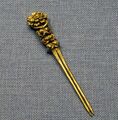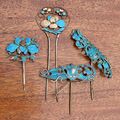Religion:Chinese hairpin
Ji (筓) (also known as fazan (髮簪 or 发簪), zanzi (簪子) or zan (簪) for short)[1][2] is a generic term for hairpin in China .[3] 'Ji' (with the same character of 笄) is also the term used for hairpins of the Qin dynasty.[4]
Hairpins are an important symbol in Chinese culture,[1] and are associated with many Chinese cultural traditions and customs.[5] They were also used as every day hair ornaments in ancient China;[3] all Chinese women would wear a hairpin, regardless of their social rank.[6] The materials, elaborateness of the hairpin's ornaments, and the design used to make the hairpins were markers of the wearer's social status.[1][5] Hairpins could be made out of various materials, such as jade, gold, silver, ivory, bronze, bamboo, carved wood, tortoise shell and bone, as well as others.[3][7][1][8]
Prior to the establishment of the Qing dynasty, both men and women coiled their hair into a bun using a ji.[3] There were many varieties of hairpin, many having their own names to denote specific styles, such as zan, ji, chai, buyao and tiaoxin.[9][3][10]
Customs and cultural symbolism
Burials
During the Chinese funeral period, women in mourning were not allowed to be wear hairpins.[1]
Ji ceremony
Ji played an important role in the coming-of age of Han Chinese women.[1][4] Before the age of 15 years old, women did not use hairpins, and always kept their hair in braids.[1] When a woman turned 15, she stopped wearing braids, and a hairpin ceremony called "Ji Li" (笄礼), or "hairpin initiation", would be held to mark the rite of passage.[3][1][5][4] During the ceremony, their hair would be coiled into a bun with a ji hairpin.[1][4] After the ceremony, the woman would be eligible for marriage.[3][5][4]
Hairpins as a love token
Betrothal and wedding customs
When engaged to be married, Chinese women would take the hairpin from their hair and give it to their male fiancé.[1] After the wedding, the husband would then return the hairpin to his newly-wed wife by placing it back in her hair.[1]
Separation and reunion love token
The chai hairpin[11] also used to be a form of love token; when lovers were forced to break apart, they would often break a hairpin in half, and each would keep half of the hairpin until they were reunited.[3]
Similarly, when married couples were separated for a long period of time, they would break a hairpin in two and each keep one part.[1] If they were to meet again in the future, they would then put the hairpin together again, as a proof of their identity and as a symbol of their reunion.[1]
Design and construction
Materials
Initially, Chinese people liked hairpins which were made out of bone and jade.[12] Hairpins which were made out of carved jade appeared in China as early as the Neolithic Period (c. 3000-1500 BC), along with jade carving technology.[6] Some ancient Chinese hairpins dating from the Shang dynasty can still be found in some museums.[13]
By the Bronze Age, hairpins which were made out of gold had been introduced into China by people living on the country's Northern borders.[12] Some ancient Chinese hairpins dating back to 300 BC were made from bone, horn, wood, and metal.[7]
The art of engraving wood first appeared in the Tang dynasty, and this new form of art was then applied to large wooden Chinese hairpins.[14] Many of these wooden hairpins were then coated with silver.[14]
In the Ming dynasty, the hairpins became more elaborate, and the carvings were made on silver, ivory, and jade, with pearl being used often as a setting.[14]
Decorations
Hairpins could also be decorated with gemstones, as well as designs of flowers, dragons, and phoenixes.[7]
Types of Chinese hairpins
There are various types of Chinese hairpins:
Buyao
The buyao was an elaborate and exquisite form of hairpin which denoted noble status.[3] It was generally made of gold and was often decorated with jewels (such as pearls and jade) and carved designs (such as in the shape of dragons or phoenix).[3][12] It looked similar to a zan,[11] but one of its main characteristics is its dangling features, which gave it its name 'buyao' (lit. "shake as you go" or "that sway with each step" or "step shake").[3][8][15][11] The buyao became popular in the Western Han dynasty.[12]
Chai
The chai is a type of hairpin with double or multiple pins.[9][8] The double-pin chai evolved from the zan; it was frequently found in Chinese poetry and literature as it played an important symbol and as a love token.[11]
Diancui hairpin
The diancui hairpin, also known as "kingfisher feather hairpin",[16] were made using the traditional Chinese art of diancui.[15]
Jin chan yu yue
Known as the "gold cicada on a jade leaf" hairpin, or "jin zhi yu ye" (a homonym for the Chinese idiom "one of noble birth"),[17] a type of Ming dynasty hairpin in the shape of a cicada made of gold sitting on a piece of jade carved in the shape of a leaf.[8][17]
Tiaoxin
The tiaoxin is a Chinese hairpin worn by women in the Ming dynasty in their hair bun; the upper part of the hairpin was usually in the shape of a Buddhist statue, an immortal, a Sanskrit word, or a phoenix.[10] The Chinese character shou (寿, "longevity") could also be used to decorate the hairpin.[10]
Zan
The zan is a type of hairpin with a single pin.[9][8] The zan could also come in different styles such as:[9]
- Ji-style: A style of zan hairpin which likely refers to the hairpin used to secure the hair in a bun.[9]
- Ruyi-style: A style of zan hairpin in the shape of a ruyi scepter.[9]
- Tiger-head style[9]
- Round-dragon style[9]
See also
- Hairpin
- Hair stick
- List of Hanfu headwear
- Kanzashi - the Japanese equivalent
- Binyeo - the Korean equivalent
References
- ↑ 1.00 1.01 1.02 1.03 1.04 1.05 1.06 1.07 1.08 1.09 1.10 1.11 1.12 "Hairpins in Society and Art" (in en). https://www.hairpinmuseum.org/hairpins-in-society-and-art.html.
- ↑ Wu, Shu-Ling (2019). Mastering advanced modern Chinese through the classics. Haiwang Yuan. Abingdon, Oxon: Taylor & Francis. pp. 125, 233. ISBN 978-1-315-20897-8. OCLC 1053623258. https://www.google.ca/books/edition/Mastering_Advanced_Modern_Chinese_throug/CZh2DwAAQBAJ?hl=en&gbpv=1&dq=china%20hairpins&pg=PA125&printsec=frontcover&bsq=china%20hairpins.
- ↑ 3.00 3.01 3.02 3.03 3.04 3.05 3.06 3.07 3.08 3.09 3.10 "Historical hair ornaments and their social connotations". http://usa.chinadaily.com.cn/culture/2011-03/04/content_12118404.htm.
- ↑ 4.0 4.1 4.2 4.3 4.4 Hidden dimensions of education : rhetoric, rituals and anthropology. Werler, Tobias. Wulf, Christoph. Waxmann. 2006. pp. 165–168. ISBN 3-8309-1739-2. OCLC 470776855. https://www.google.ca/books/edition/Hidden_Dimensions_of_Education/FadBa6mwEcQC?hl=en&gbpv=1&dq=chinese%20hair%20ornaments%20ji&pg=PA165&printsec=frontcover&bsq=chinese%20hair%20ornaments%20ji.
- ↑ 5.0 5.1 5.2 5.3 "Chinese cloisonne hairpin" (in en). https://collection.maas.museum/object/564559.
- ↑ 6.0 6.1 "Material & Technology" (in en). https://www.hairpinmuseum.org/material--technology.html.
- ↑ 7.0 7.1 7.2 Sherrow, Victoria (2006). Encyclopedia of hair : a cultural history. Westport, Conn.: Greenwood Press. pp. 179. ISBN 0-313-33145-6. OCLC 61169697. https://www.worldcat.org/oclc/61169697.
- ↑ 8.0 8.1 8.2 8.3 8.4 Yuan, Xiaowei (2017). "Traditional Chinese Jewelry Art: Loss, Rediscovery and Reconstruction Take Headwear as an Example" (in en). Proceedings of the 2nd International Conference on Contemporary Education, Social Sciences and Humanities (ICCESSH 2017) (Atlantis Press): 550–554. doi:10.2991/iccessh-17.2017.135. ISBN 978-94-6252-351-7. https://www.atlantis-press.com/proceedings/iccessh-17/25878666.
- ↑ 9.0 9.1 9.2 9.3 9.4 9.5 9.6 9.7 Living the good life : consumption in the Qing and Ottoman empires of the eighteenth century. Elif Akçetin, Suraiya Faroqhi. Leiden: Brill. 2018. pp. 205. ISBN 978-90-04-35345-9. OCLC 1008768840. https://www.google.ca/books/edition/Living_the_Good_Life/ojE9DwAAQBAJ?hl=en&gbpv=1&dq=chinese%20hair%20ornaments%20zan&pg=PA205&printsec=frontcover&bsq=chinese%20hair%20ornaments%20zan.
- ↑ 10.0 10.1 10.2 "Golden Hairpin Decorated with Character "Shou" - Chengdu Museum". https://www.cdmuseum.com/en/mq/201901/60.html.
- ↑ 11.0 11.1 11.2 11.3 "Tradition of China - Hair Ornament Culture | ChinaFetching" (in en). https://www.chinafetching.com/tradition-of-china-hair-ornament.
- ↑ 12.0 12.1 12.2 12.3 "Hair Accessories - MIHO MUSEUM". https://www.miho.jp/booth/html/artcon/00000434e.htm.
- ↑ "Hairpin 13th–11th century B.C. China". https://www.metmuseum.org/art/collection/search/45177.
- ↑ 14.0 14.1 14.2 Lester, Katherine Morris (2004). Accessories of dress : an illustrated encyclopedia. Bess Viola Oerke, Helen Westermann. Mineola, New York. pp. 118. ISBN 978-0-486-14049-0. OCLC 857715305. https://www.google.ca/books/edition/Accessories_of_Dress/mHDTMcfDyekC?hl=en&gbpv=1&dq=chinese%20hairpins&pg=PA118&printsec=frontcover&bsq=chinese%20hairpins.
- ↑ 15.0 15.1 Wu, Yiqian (2020). "A Study of Historical Transformation and Cultural Change in Chinese Dian-cui Jewellery [Thesis"]. University of Sydney: 21, 30, 33, 43–44. https://hdl.handle.net/2123/24005.
- ↑ "Kingfisher feather hairpin from China" (in en). https://collection.maas.museum/object/188707.
- ↑ 17.0 17.1 Liu, Fang (2011). "Rare collections of the Ming and Qing Dynasties". https://europe.chinadaily.com.cn/culture/2011-04/06/content_12280357.htm.




















